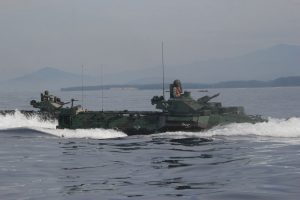Late last month, the Philippine Marine Corps (PMC) announced the approval of a new operating doctrine, which it refers to as the Archipelagic Coastal Defense (ACD) Concept. According to the accompanying press release, the ACD Concept “stipulates the roles of the Marines and how they should operate and adapt to the current and future operating environment” and how they will be “integrated in naval, joint, and inter-agency operations.” As an operating concept, ACD articulates the ways the Marine Operating Forces (MOFs) shall be employed in various scenarios through their seaward, landward, and supporting maneuvers.
The ACD Concept is a positive development both for the Philippine Navy’s service-wide Active Archipelagic Defense Strategy (AADS) and for the development of the PMC’s capabilities. It is also clear a fitting operational concept for the defense and security of an archipelagic state like the Philippines, which has more than 7,600 islands and boasts a total coastline of 36,289 kilometers.
Similar to the objective of its previous operating concept of “seaborne warfighting,” the Marines are seeking to adapt to the evolving security environment and guide its force employers on how to employ MOFs in the region. The ACD may therefore be considered a continuation and extension of its previous iteration. While the previous operating concept emphasized amphibious maneuvers, the ACD emphasizes coastal defense and a more outward-looking MOF. It also underscores that the composition of coastal defense is not limited to missiles, rockets, and guns, but is also defined by having capable and ready maneuver forces, support systems, maritime forces, and sustainment capabilities. It is the simultaneous development and integration of these capabilities that will determine the strategic and operational success of the ACD Concept.
The ACD doctrine also highlights the importance of the Marines for the Philippines’ external defense, particularly their support to the naval fleet, air force, and ground forces in joint operations. The new operating concept, as it aligns with higher strategies and plans, may indicate that the military is beginning to adopt a strategy of anti-access and area denial (A2/AD) for its joint operations. Southeast Asian states, except Vietnam, do not seem to be deliberately adopting A2/AD strategies to counter China’s growing maritime power in the South China Sea; however, the capability development of their militaries shows signs that the value of A2/AD strategies is widely recognized.
The ACD Concept of the Philippine Marines seems to be headed in this direction. It appears to be espousing the employment of the MOFs for A2/AD and archipelagic maneuvers in support of maritime law enforcement and internal security operations. Notably, in January, shortly after the creation of a new Marine Coastal Defense Regiment, the PMC pointed out that it aims to enhance and improve its sea control capabilities on the basis of A2/AD as a means of safeguarding the nation’s territorial integrity. Thus, the ACD Concept articulates a clear role for the Marines in the overall defense of the country.
Recent developments aimed at beefing up the Philippines’ future coastal defense capabilities also include the creation of the Coastal Defense Regiment (CDR) mentioned above – a unit “designed to protect the country’s shores, ships, and amphibious task forces against an invading enemy and to improve support of naval operations.” In terms of capabilities needed for the execution of this new operating concept, the PMC has also identified the need for shore-based anti-ship missile system (SBASMS), shore-based air defense system (SBADS), Man Portable Air Defense System (MANPADS), Multi-launched Rocket System (MLRS), and the deployment of howitzers. Sustained support from the central government is therefore critical for the full operationalization of the CDR and the acquisition of these capabilities.
Apart from its military function, the PMC remains committed to its support to other government agencies and security forces in conducting maritime law enforcement operations in municipal coastal waters, border control operations, and other constabulary functions. However, the support for law enforcement and other constabulary missions should not be viewed as spreading the Marines too thin to respond to several mission areas. Instead, its involvement in these operations is best viewed from an inter-agency and collaborative perspective.
The Marines have always been a force in readiness capable of scaling and adapting to achieve its mission and objectives. Its ACD Concept reflects the intent of the PMC leadership, as well as the leadership of the Philippine Navy, to define, and redefine when necessary, the role of the Marines in the defense and security of the country. Moreover, this initiative indicates that the continuous development of the country’s maritime forces reflects the importance of the Philippines’ archipelagic status as well as its current and future security environment.
The ACD is also an effort by the PMC to communicate to its stakeholders what it could offer and accomplish in relation to the country’s national security objectives. Its stakeholders must now reciprocate by supporting the Marines in ensuring that the ACD’s operationalization produces positive and beneficial outcomes for the Philippines.

































